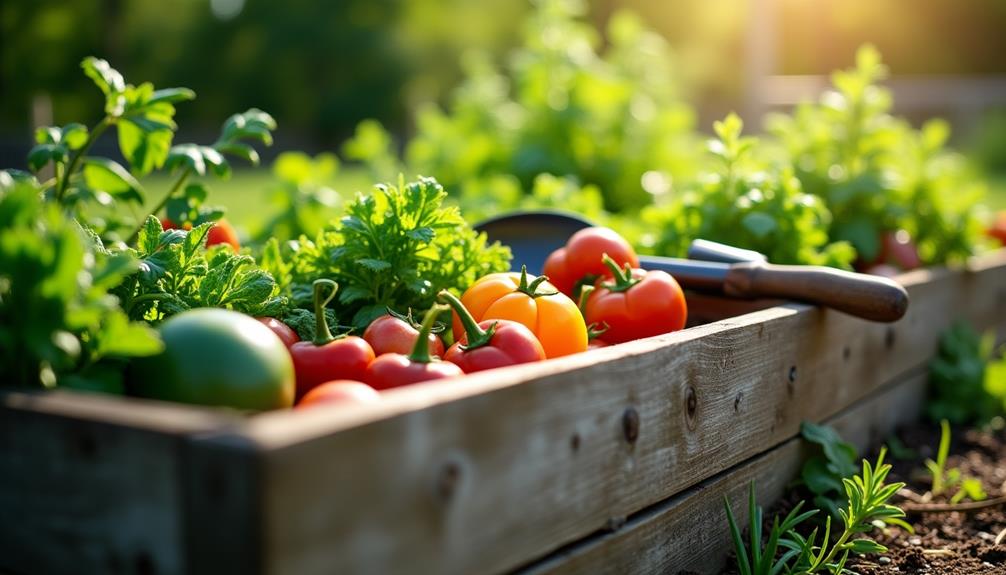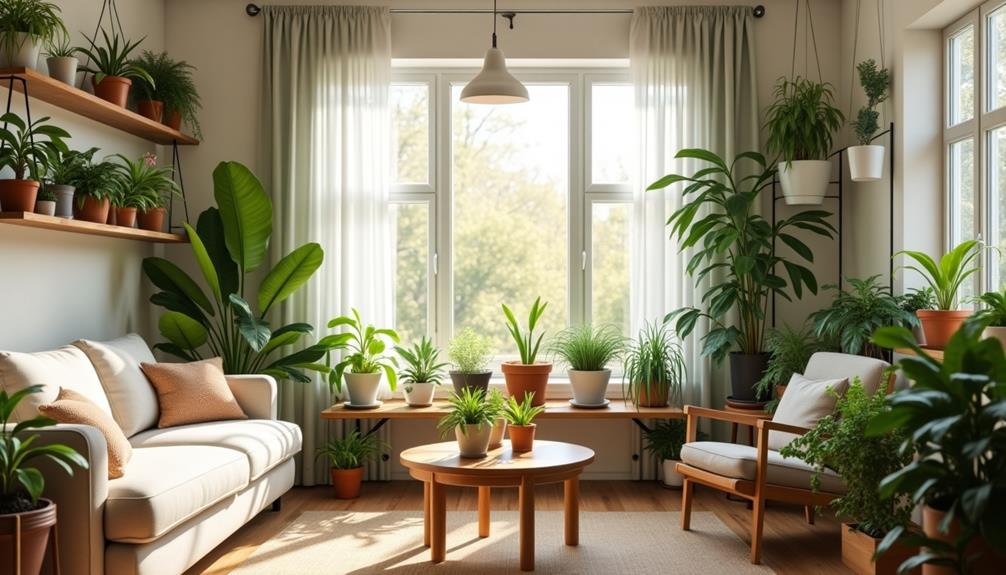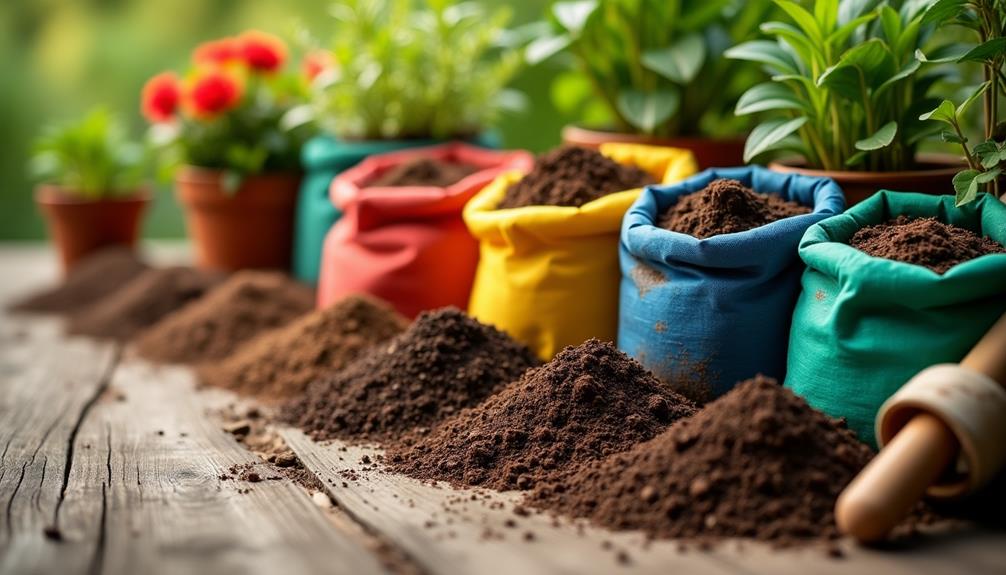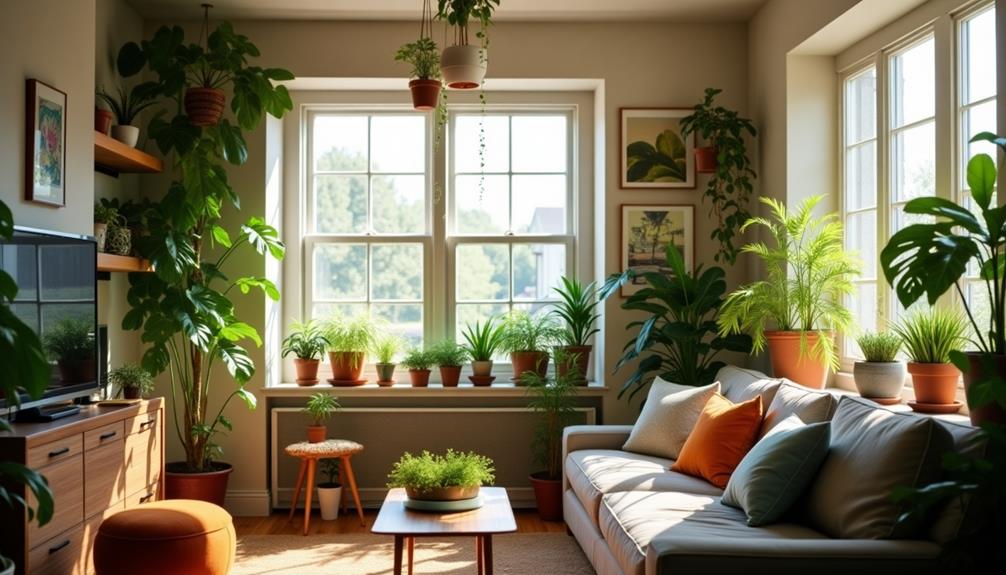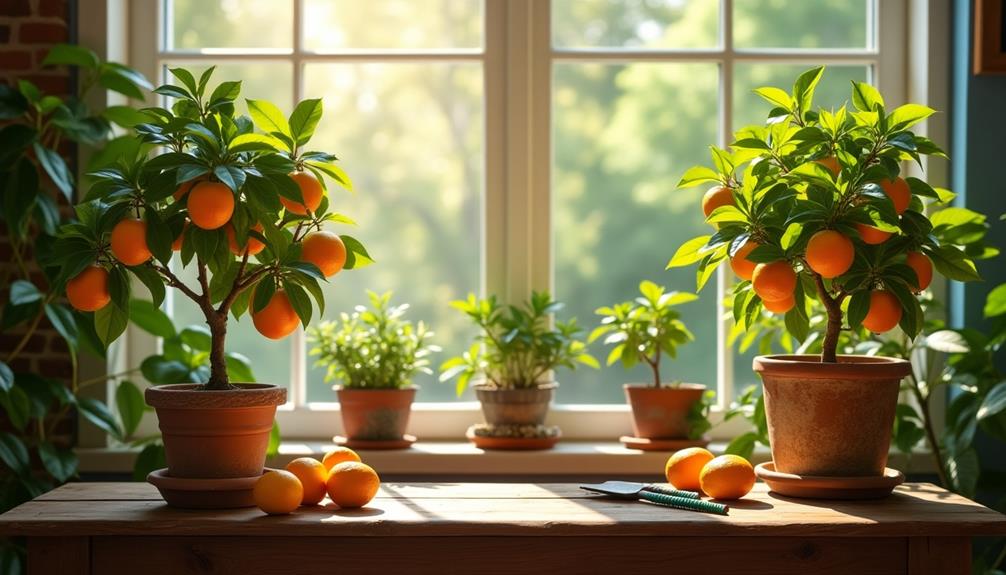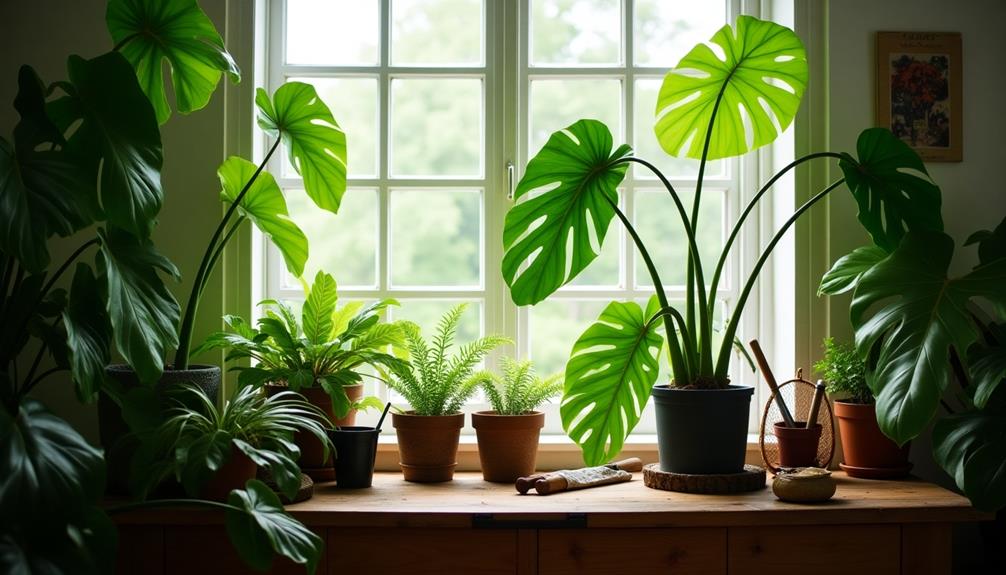Isn't it intriguing how a simple wooden frame can transform your gardening experience? When you consider the benefits of a DIY raised garden bed, it becomes clear that this project offers more than just a place to plant. You'll find improved soil drainage and easier access, but the right materials and location can make all the difference. So, what should you keep in mind as you embark on this gardening venture? Exploring these aspects could lead you to a fruitful and satisfying garden.
Benefits of Raised Garden Beds
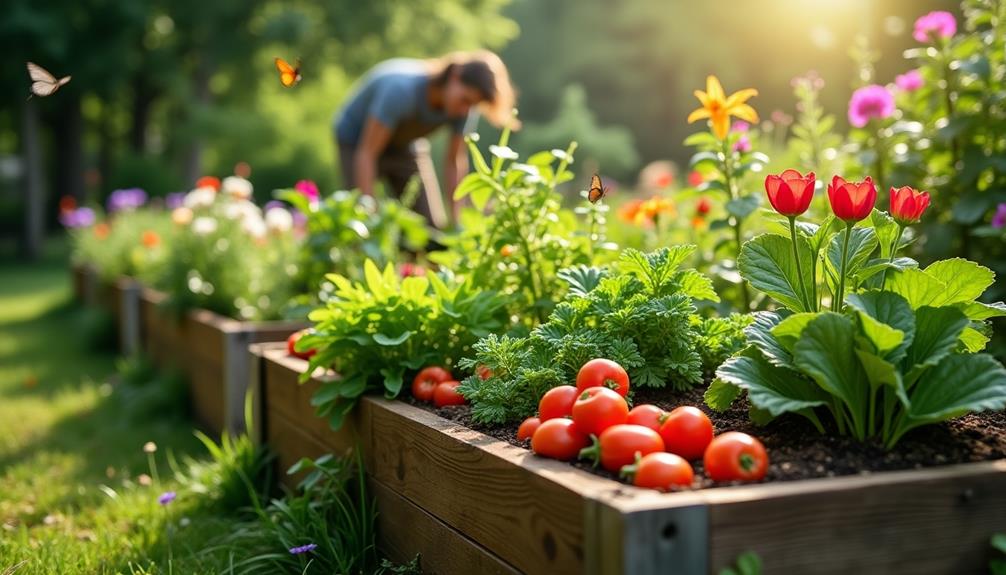
When considering a gardening upgrade, raised garden beds offer numerous advantages that can transform your planting experience. They utilize space efficiently, allowing you to grow more in a smaller area.
With their elevated design, you'll enjoy easier access, making it simple to tend to your plants without straining your back.
Raised beds also excel in pest control. By keeping your plants off the ground, you reduce the chances of pests invading your garden. The improved soil drainage promotes healthier roots, while effective weed reduction means less time spent on maintenance.
Additionally, the structure helps with temperature regulation, warming the soil earlier in the spring and extending your growing season.
With raised garden beds, you can practice crop rotation more easily, enhancing soil health and sustainability practices. Plus, their aesthetic appeal can elevate your garden's look, creating an inviting space for gardening enjoyment.
Ultimately, these benefits combine to create a more productive, enjoyable gardening experience that you'll appreciate year after year.
Choosing the Right Location
Selecting the perfect spot for your raised garden bed is crucial for maximizing plant health and productivity. First, consider sunlight exposure; most vegetables need at least six hours of direct sunlight daily.
Next, think about drainage considerations. Avoid low-lying areas where water tends to pool, as good drainage helps prevent soil erosion and root rot.
Accessibility factors are also important. Position your bed where you can easily reach it for planting, watering, and harvesting.
Additionally, plan for wildlife protection. If deer or rabbits frequent your yard, consider installing barriers to keep them at bay.
Wind barriers can shield your plants from harsh gusts, which can damage foliage and stunt growth.
Also, think about the aesthetic appeal of your garden. A well-placed raised bed can enhance your landscape while providing a functional space for growing.
Lastly, keep pest control in mind. Positioning your bed away from dense shrubs or tall plants can reduce pest infestations.
Selecting Materials for Construction
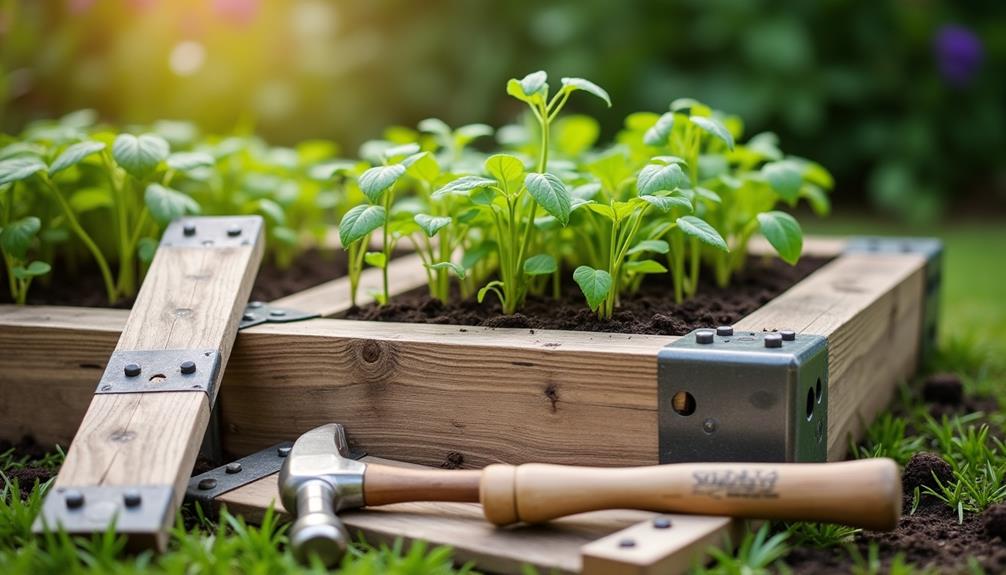
To build a durable and effective raised garden bed, you need to choose the right materials. Start by considering wood options like cedar or redwood, known for their natural resistance to rot.
If you prefer metal alternatives, galvanized steel or aluminum can add a modern touch while ensuring longevity. For a more eco-friendly choice, explore composite materials, which combine recycled wood fibers and plastic, reducing waste.
Think about drainage considerations; ensure your design allows excess water to flow out, preventing root rot. Height variations can also impact your plants; a bed between 12 to 24 inches works well for most veggies.
Don't forget to weigh the cost comparisons—wood tends to be cheaper, while metal and composites may require a higher initial investment.
Sustainability factors matter too. Opt for materials that are sustainably sourced or recycled.
Aesthetic choices play a role in your garden's appeal; choose colors and textures that complement your landscape.
Lastly, consider wildlife protection; raised beds can deter pests when constructed with proper barriers.
Tools You'll Need
After gathering the right materials for your raised garden bed, it's time to gather the tools that will help you assemble it efficiently.
Start with essential equipment like measuring tools to ensure accurate dimensions. You'll need a tape measure and a square to keep everything straight and level.
Next, grab some cutting tools, such as a saw, to cut your materials to size. For assembly, a drill or screwdriver is crucial for securing the pieces together.
Don't forget your safety gear—gloves and safety glasses are a must to protect yourself during the build.
Once your bed is set up, you'll want to shift focus to planting tools for sowing seeds or transplanting seedlings. In addition, consider irrigation tools like a hose or watering can to keep your plants hydrated.
Lastly, weeding tools will be handy for maintaining your garden bed throughout the growing season.
Step-by-Step Building Instructions
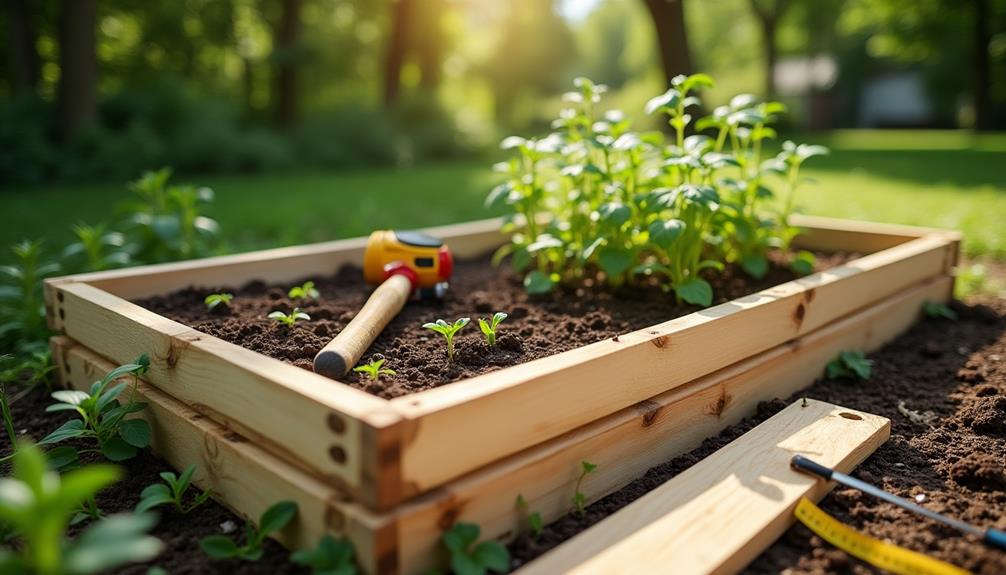
Building your raised garden bed involves a straightforward process that makes it easy to create a space for your plants. Start by choosing your design variations; rectangular, square, or even circular beds can enhance your garden aesthetics.
Cut your lumber to size and assemble the frame using screws or brackets, ensuring it's sturdy.
Next, place the bed in a sunny spot, considering watering strategies. A location with easy access to water will make your gardening more manageable.
Once the frame is in place, fill it with a mix of soil amendments, like compost and organic matter, to provide nutrients for your plants.
When planting, think about companion planting to improve pest management and enhance growth.
Rotate your crops seasonally to maintain soil health and maximize yield. Consider planting seasonal crops that thrive in your climate, ensuring a bountiful harvest.
Soil Preparation Tips
When preparing your raised garden bed, choosing quality soil is crucial for healthy plants.
You'll want to enrich it with organic matter and test the soil pH to ensure optimal growth.
Let's explore these essential steps to create the perfect foundation for your garden.
Choosing Quality Soil
As you prepare your raised garden bed, selecting the right soil is crucial for your plants' success. Start by considering different soil types. A mix of loam, sand, and clay can provide a great balance.
Look for options that offer good drainage solutions, as excess water can harm roots.
To enhance your soil's nutrient balance, consider incorporating soil amendments like compost or aged manure. These not only boost nutrients but also improve moisture retention, ensuring that your plants have what they need to thrive.
Don't overlook the importance of pest control when choosing soil. Some local sources offer pre-treated soils that minimize pests naturally.
You can also practice soil layering, placing heavier materials at the bottom and lighter ones on top. This helps with drainage while keeping nutrients where they're needed.
Adding Organic Matter
Incorporating organic matter into your raised garden bed is essential for creating a healthy soil environment. Organic matter improves soil structure, enhances nutrient retention, and promotes beneficial microorganisms.
Start by selecting the right compost types to enrich your soil. You can choose from options like well-aged manure, leaf mold, or kitchen scraps. Each type adds different nutrients and benefits, so mix them to create a balanced blend.
Next, consider adding organic fertilizers to further boost your soil's fertility. Organic fertilizers, such as bone meal, blood meal, or fish emulsion, provide slow-release nutrients that plants can absorb over time. This gradual feeding process helps prevent nutrient burn and supports healthy growth.
When preparing your raised bed, aim for a mixture of at least 30% organic matter. Spread your compost and organic fertilizers evenly and then mix them thoroughly with your existing soil.
This combination will create a nutrient-rich environment that supports strong root development and enhances overall plant health. By adding organic matter, you're not just improving your soil; you're setting the foundation for a thriving garden that produces bountiful crops.
Happy gardening!
Testing Soil Ph
After enriching your soil with organic matter, it's important to assess its pH level. Soil testing is crucial because pH levels directly impact nutrient balance and soil health. A pH level that's too high or too low can hinder your plants' ability to absorb essential nutrients, affecting your garden success and crop yield.
To determine your soil's pH, you can use various testing methods, including professional lab analysis or DIY testing kits available at garden centers. These kits are user-friendly and typically involve mixing a small soil sample with a solution, then comparing the resulting color to a provided scale.
Understanding the importance of pH allows you to make informed decisions about soil amendments. If your soil is too acidic, you might add lime; if it's too alkaline, sulfur could help lower the pH.
Regular testing ensures that your soil remains optimal for plant growth, setting the stage for a thriving garden. By monitoring soil pH, you're taking an essential step toward maximizing your garden's potential and ensuring that your plants receive the nutrients they need to flourish.
Planting in Your Raised Bed

How do you ensure that your raised garden bed thrives from the moment you plant? Start by choosing the right plants for your space, considering both their sunlight needs and growth habits. You can maximize your garden's potential through companion planting, which pairs compatible plants together to enhance growth and deter pests. For instance, planting marigolds alongside your vegetables can help ward off unwanted insects.
Once you've selected your plants, consider the layout of your raised bed. Taller plants should go at the back, while shorter ones can fill in the front. This arrangement not only optimizes sunlight exposure but also makes it easier to tend to your plants.
When planting, make sure to dig holes that are appropriate for each plant's root system and space them adequately to allow for growth. Don't forget to water your plants thoroughly after planting, ensuring the soil is moist but not waterlogged.
Lastly, keep an eye on pest management. Regularly inspect your plants for signs of pests, and use natural methods like neem oil or insecticidal soap if needed. With these tips, your raised garden bed should flourish in no time!
Maintenance and Care
Once your plants are settled in their new home, maintenance and care become vital for their success. Start by implementing effective pest management strategies to protect your plants from unwanted invaders. Regularly inspect your garden for pests and use organic solutions to keep them at bay.
Next, focus on weed control; pull weeds by hand or use mulch to suppress their growth.
Watering strategies are also crucial. Water deeply but infrequently to encourage deep root growth. Adjust your watering based on the season and rainfall. Consider crop rotation each year to maintain soil health and reduce pest buildup.
Seasonal mulching not only suppresses weeds but also retains moisture and adds nutrients as it breaks down. Pair plants wisely through plant companioning to enhance growth and deter pests naturally.
Additionally, using organic fertilizers can help provide essential nutrients without harming the environment.
Finally, pay attention to harvest timing. Picking your crops at their peak ripeness ensures the best flavor and encourages further growth.
Seasonal Planting Recommendations
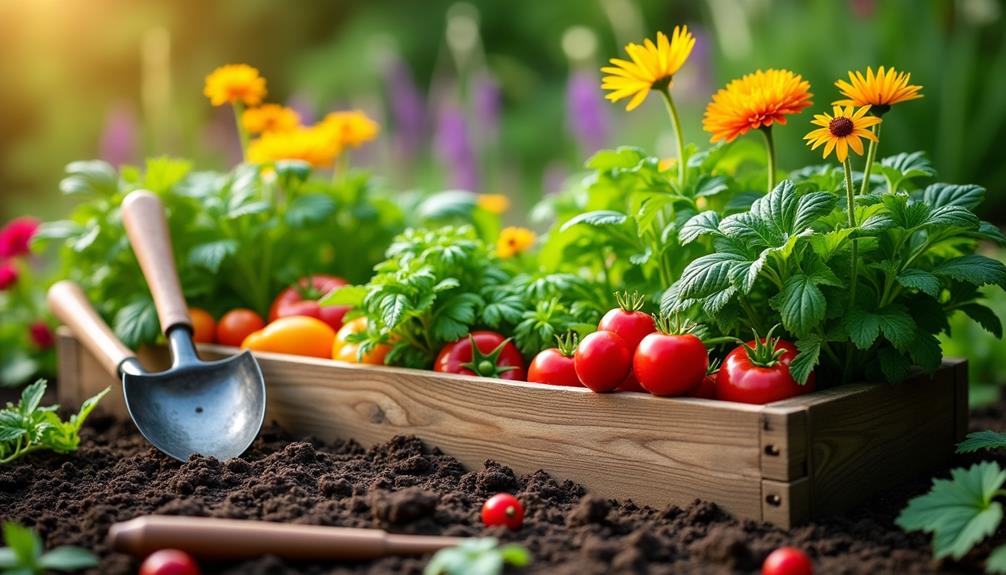
When it comes to seasonal planting in your raised garden bed, timing is key.
In spring, you'll want to focus on cool-weather crops, while summer brings a chance to grow heat-loving vegetables.
As fall approaches, consider harvesting hearty varieties that thrive in cooler temperatures.
Spring Planting Choices
Spring arrives with a burst of color and life, making it the perfect time to plan your garden. As you prepare your raised garden bed, consider what vegetables and herbs you want to plant. This season's ideal choices include leafy greens like lettuce and spinach, as well as root vegetables such as carrots and radishes.
Don't forget about companion planting! Pairing plants that benefit each other can enhance growth and deter pests. For example, planting basil alongside tomatoes can help repel harmful insects while boosting tomato flavor.
Incorporating flowers like marigolds in your garden can also assist with pest management. Their vibrant blooms attract beneficial insects, which can keep harmful pests at bay.
Be mindful of your planting schedule, as some seeds prefer cooler soil temperatures. Start with hardy crops, then gradually introduce more delicate plants as the risk of frost diminishes.
Summer Crop Suggestions
As the days grow warmer and longer, it's time to think about what to plant in your raised garden bed for the summer months. Consider summer staples like tomatoes, peppers, and cucumbers, which thrive in the heat. These crops not only provide delicious harvests but also complement each other well through companion planting. For instance, planting basil alongside tomatoes can enhance flavor and deter pests.
To maximize your garden's health, focus on pest management strategies. Marigolds are excellent companions as they repel harmful insects while attracting beneficial ones. You might also try planting nasturtiums, which act as a trap crop, luring pests away from your primary plants.
Don't forget about quick-growing options like radishes and salad greens, which can be harvested before your larger crops take off. These can help you enjoy fresh produce sooner and make the most of your growing space.
Make sure to water consistently, especially during hot spells, and regularly check for pests to keep your garden thriving.
With these summer crop suggestions, you'll be well on your way to a bountiful harvest in your raised garden bed. Happy gardening!
Fall Harvest Ideas
With the arrival of fall, it's the perfect time to plan for a bountiful harvest in your raised garden bed. This season, focus on planting fall vegetables that thrive in cooler temperatures, like kale, carrots, and Brussels sprouts. These seasonal crops aren't only delicious but also packed with nutrients.
Start your autumn planting by preparing your soil and ensuring it's rich in organic matter. This will help your plants withstand the cold weather gardening conditions.
You might also consider using row covers to protect your crops from frost and extend your growing season.
As you harvest your vegetables, think about how to incorporate them into your meals. You can try out various harvest recipes, like roasted root vegetables or hearty soups, which are perfect for cozy fall nights.
Don't forget to practice late season care; continue to water your plants and keep an eye out for pests as the temperatures drop.

